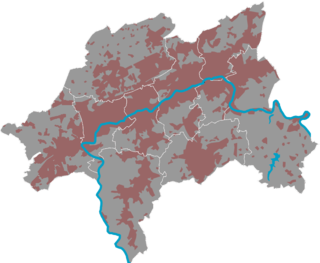Dwarf Cave (Wuppertal)
| Dwarf cave
|
||
|---|---|---|
| Location: | Wuppertal | |
|
Geographic location: |
51 ° 15 '0 " N , 7 ° 9' 36" E | |
|
|
||
| Type: | Karst cave | |
The dwarf cave ( alternatively: dwarf hole ) was a cave in the Wuppertal city area. It was destroyed in the 19th century.
Location and description
The cave was located in the rock of the Upper Honsel Strata , which date from the time of the Upper Middle Devonian. This is the same rock layer in which the Hardthöhlen can be found around 1.5 kilometers away , a cave system that is one of the largest in the Rhineland. The dwarf cave was located south of the Wupper in the locality of Kluse . The exact location and size is not documented. There are no other records of the cave; there was no scientific investigation before the destruction.
history
During the construction of the Elberfeld – Dortmund railway on the Bergisch-Märkische Eisenbahn from 1844, the cave or at least the access to it was destroyed. The notch valley in the Kluse was filled with waste material in order to keep the level of the railway line. The central workshop of the Bergisch-Märkische Eisenbahn was built on this site.
In a Bergisch legend "Vom Zwergenloch an der Kluse" it is about the dwarf cave:
“ From the dwarf hole at the Kluse.
There was a time when things looked very different here in Wuppertal than today. There was no sign of any houses. Wooded mountains accompanied the Wupper on its course. Sky and trees were reflected in the clear water of the river. The mountains came closest to the Wupper at Kluse. The quiet valley with its wooded hills was chosen by dwarfs as their place of residence. They preferred to be at the Kluse and in Iceland. During the day they worked hard in the interior of the mountains, forged precious weapons and implements or dug in the earth for treasures, for precious stones and pearls. In the evenings, when the little men were tired from work, they wandered around in the forest or rested under shady trees. Even when individual people built their huts in Wuppertal, the good dwarfs stayed. Many a hiker who walked through the forest at the Kluse at dusk has seen the little men. Often times the dwarfs would stop the passers-by and chat comfortably with them. But the people had to be good and pious. The dwarves did not tolerate naughty talking or doing in their vicinity. Little by little, more and more people moved here. In place of the small houses in which the yarn bleachers lived, factories were built. The water of the Wupper became cloudy and tired from all the work; it no longer flowed so briskly. The people cut down some forests; houses were built on the hills. The Kluser forest also disappeared. That made the little men uncomfortable. They left the once so quiet valley and never returned. "
Another quote from the saga:
“ The dwarf hole near Elberfeld.
In the Kluse near Elberfeld, before the Bergisch-Märkische Railway was built, the Zwergenloch led from the Wupper into the steep slope of the Döppersberg. There was the entrance to the realm of the black elves or dwarves. From there, the small, misshapen, but good-natured creatures visited the cave until the beginning of the present century and strolled in the shade of the beeches and oaks, probably also, despite their shy character, conversed with people if one met them honestly, friendly traffic. Because these meerkats, who collect treasures in the crevices and caves of the mountains, forge magnificent weapons and build magnificent palaces, got along very well with people, even when other activities took the place of yarn bleaching in the Wuppertal. But when the railroad was being built, it was also the hour of the common people. "
Individual evidence
- ↑ ubraemer: Cave finds on Döppersberg. In: wordpress.com. July 23, 2015, accessed January 15, 2017 .
- ↑ Carl Schieferdecker, Otto Schillmann: Bergische Sagen . Bacmeister, Elberfeld 1911, p. 2 , urn : nbn: de: 0220-gd-8885931 .
- ↑ Legends from the Rhineland . 2017 ( online [accessed January 15, 2017]).
